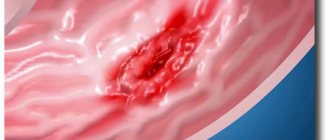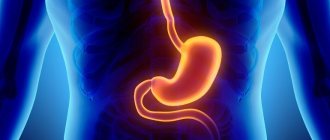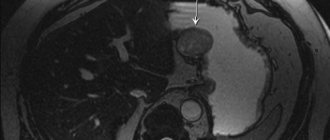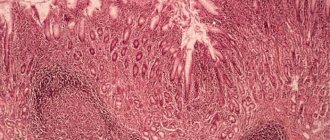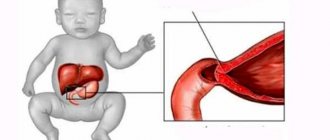What's happened
Infiltrative disease of the stomach is a malignant tumor that grows into the gastric walls and does not have a clearly defined shape. Infiltrate in the stomach in most cases is detected in its lower parts. Sometimes the entire organ can be affected.
In the field of oncology, this type of cancer is often called adenocarcinoma. Its malignancy is evidenced by the early manifestation of metastases and the rapid growth of pathological tissue structures.
According to observations, it was found that patients with infiltrative cancer were diagnosed with atrophic type gastritis.
On this topic
- Oncogastroenterology
Feces for stomach cancer
- Natalya Gennadievna Butsyk
- December 6, 2021
The oncological process is characterized by the following features:
- multiple formation mutated cells, lesions are located at a distance of approximately seven centimeters from each other;
- thickening of the tumor consistency, especially in the later stages of the process;
- damage to both adults and children;
- aggressiveness of the disease;
- early metastasis.
In addition, the peculiarity of infiltrative cancer is that the entire organ is affected at once. This is explained by the scattering of mutated cells throughout the mucosa.
As the tumor completely grows into adjacent tissues, peristalsis is disrupted and the walls lose their original elasticity.
Since the tumor does not have clear boundaries, it quickly spreads in different directions and affects healthy tissue. As a result, against the background of narrowing of the gastric lumen, the structures of the organ gradually deteriorate.
Forecast
How long people live with an infiltrative tumor of the stomach depends on the timeliness and correctness of the treatment used. Very often, the diagnosis of pathology and the beginning of its treatment is made in the later stages of the development of the disease. However, even in such situations, the survival prognosis for infiltrative gastric cancer is quite optimistic.
The chances of exceeding the 5-year survival threshold are:
- At the 1st stage of development of oncological education, more than 72%;
- With stage 2 of the disease, about 47%;
- In patients with stage 3 oncology – 28%;
- At stage 4 of disease progression, in which numerous extensive metastases are observed, this figure is 3%. In this case, the patient requires constant use of supportive medications and procedures.
In the absence of treatment, about 85% of patients do not overcome the 3-year mark.
Classification
Infiltrative stomach cancer is divided into 2 types. In the field of oncology, classification is based on the Borrmann system, where the appearance of the tumor is taken as the basis for the division.
Diffuse-infiltrative
It is practically impossible to detect this form of the disease in the body of an organ using endoscopic examination. For diagnosis, certain signs are taken into account.
First of all, the affected walls will be rigid. In other words, they completely lose their elasticity. It is also necessary to take into account the smoothness of the surface relief, the pallor of the mucous membrane and its lifeless color.
Ulcerative-infiltrative
The picture obtained during endoscopic examination resembles the formation of an ulcer, which has undefined edges and a tuberous bottom.
To identify the infiltrative-ulcerative form, it is also necessary to take into account certain indicators characteristic of this clinical picture. First of all, this is the presence of rigid folds, similar color of the mucous membrane and the edge of the ulcer, and the roughness of the relief.
Stages
Infiltrative cancer goes through five stages of its development.
Zero
The condition is considered precancerous, that is, the tumor has not yet formed, but the presence of uncontrolled division of a separate group of cells is already observed. In addition, there is no damage to lymph nodes and distant structures.
First
The size of the neoplasm reaches no more than five centimeters. The submucosal and mucous membranes of the organ are subject to an atypical process. There is no metastasis to the lymphatic system.
Second
There is rapid growth of the tumor. At the same time, it begins to grow into the muscular and serous ventricular tissue. Up to six lymph nodes may be involved in the malignant process.
Third
At stage 3, the tumor begins to extend beyond the stomach. As a result, nearby lymph nodes, liver, esophagus and other organs are affected. In fact, there is no distant metastasis, but the presence of atypical cells in the lymph and bloodstream is already noted.
This stage of pathology can no longer be cured.
Fourth
With stage 4 disease, the risk of death increases significantly. The clinical picture has severe symptoms. In this case, it is possible to help only by carrying out palliative therapy.
Causes
The development of any cancer, especially when it comes to the gastrointestinal tract, is preceded by certain processes.
Thus, infiltrative type cancer in most cases appears as a result of a non-scarring ulcer or with the progression of atrophic gastritis. In this condition, degeneration of the disease into a malignant form can occur regardless of the degree of its course.
There are no exact factors predisposing to the development of cancer. Experts have put forward only a few theories that explain the process of origin of stomach cancer.
Currently, scientists have identified a number of reasons why pathology may begin to develop.
Ecological situation
With increased pollution of the environment, soil, and water, the likelihood of cancer increases significantly. This group can also include work activities associated with hazardous production.
Gastrointestinal pathologies
The disease can occur against the background of gastritis, ulcers or inflammatory processes, which are accompanied by atrophy of the gastric mucosa or polyposis.
Cancer can also develop against the background of concomitant pathologies that contribute to a decrease in the immune system and weakening of the human body.
Poor nutrition
In this case, we are talking about a lack or excess of important microelements and nutrients. This group also includes the predominance in the diet of foods with various food additives and dyes.
Failure to adhere to the temperature regime of food can also provoke the formation of a malignant tumor. When eating too cold or hot food, rapid damage to the epithelial layer occurs, which gives impetus to the onset of malignancy.
Hormonal imbalances
Sex hormones consist of two derivatives - negative and positive. Upon reaching 30 years of age, as a rule, the background shifts in a negative direction. This derivative acts as a natural carcinogen, under the influence of which cells begin to mutate and divide.
Genetic predisposition
If your immediate family has a history of cancer, the risk of stomach cancer also increases. At the same time, young people are more susceptible to cancer.
Despite the variety of provoking factors, experts consider the main cause of cancer to be a precancerous condition, that is, gastric ulcer.
Who is at risk
The following patients are at increased risk of cancer:
- With chronic atrophic gastritis.
- With a chronic stomach ulcer, especially if it is large. Malignant transformation can occur at any stage of peptic ulcer disease.
- People with a family history of stomach cancer.
- Patients who have undergone gastric surgery within the last 10 years.
- Patients with congenital and acquired immunodeficiencies.
- Workers employed in hazardous working conditions, in particular in nickel, asbestos production, rubber, chrome production, etc.
- Patients with sessile polyps.
The above categories of people are recommended to undergo timely medical examinations with fibrogastroduodenoscopy and taking a biopsy from pathological lesions. A morphological examination of the biopsy specimen determines the presence of morphological changes: cell atypia, structural changes in the tissue of the mucous membrane, etc. Such changes should be regarded as precancer and appropriate treatment should be carried out.
Symptoms
As a rule, the initial stages of cancer development often occur without the manifestation of a characteristic clinical picture. The first signs appear at a later stage. This is considered dangerous for the body, since malignancy of the ulcer or atrophy of the organ mucosa cannot be detected in a timely manner.
For this reason, if a person has stomach diseases, he needs to be regularly examined by a gastroenterologist.
Among the main signs of the development of infiltrative cancer are:
- low level of acidity, which manifests itself in disorders of the functioning of the digestive glands;
- attacks of nausea and vomiting;
- epigastric pain that has nothing to do with eating;
- internal bleeding;
- lack of appetite;
- increased fatigue;
- general weakness.
To eliminate the above symptoms, it is necessary to adjust your diet. However, it must be remembered that such a measure does not help cure the patient.
Prevention
To prevent the development of infiltrative stomach cancer, it is necessary first of all to undergo a medical examination at least once a year. In addition, it is important to monitor your diet and lifestyle, eat less salt, fatty and fried foods.
On this topic
It is also recommended to give up bad habits and follow basic hygiene rules.
Infiltrative type stomach cancer is a dangerous disease that can lead to death if therapeutic measures are not carried out in a timely manner. To detect the disease in time, you need to be regularly examined by an endocrinologist.
Infiltrative gastric cancer is a morphological form of carcinoma, which is characterized by infiltrative growth (growth through the wall of the organ) and the absence of clear tumor boundaries.
Features of infiltrative cancer:
- It is characterized by a high degree of malignancy - it grows quickly and metastasizes early.
- May occur in young people.
- The hereditary factor is clearly visible.
- As a rule, it manifests with symptoms of dyspepsia.
Diagnostics
To make an accurate diagnosis, as well as to study the formation of a malignant formation, specialists prescribe the patient to undergo a series of diagnostic measures.
Analysis for tumor markers
If specific substances are present in the body, then we can talk about an oncological process. If we are talking about infiltrative cancer, then such tumor markers as CA 19-9, CA 72-4, CA 242 and CEA are subject to study.
Only a qualified specialist can give a correct interpretation of the results.
UAC
A general analysis of blood fluid is necessary to assess the condition of the stomach, as well as to suggest malignancy of the pathological process. Cancer will be indicated by a decrease in hemoglobin and an increase in the erythrocyte sedimentation rate.
CT scan
This procedure makes it possible to assess the stage of the pathology, as well as detect metastasis.
X-ray with contrast
Not so long ago, this method was one of the most popular for identifying any diseases of the gastrointestinal tract. The essence of it is to inject a contrast agent into the stomach and obtain an image. Using images, the relief structures, size, and boundaries of tumors are studied.
Endoscopy
One of the more accurate diagnostic methods. Its accuracy is almost 100 percent.
Transabdominal ultrasound examination
Provides an opportunity to visually examine the oncological process occurring in the stomach. It can also be used to assess the nature of changes and growth of the tumor.
Treatment
The choice of therapeutic tactics is based on several indicators. In this case, it is necessary to take into account the patient’s age, stage of the disease, and the degree of damage to nearby and distant structures.
When treating infiltrative cancer, experts prefer three main methods.
Surgery
This method is radical and in most cases the only way to eliminate the tumor. Its essence is to remove the tumor and part of the affected organ.
Chemotherapy
It is usually carried out before surgery and helps to alleviate the symptoms of the pathological process. In addition, after it the likelihood of recurrence of the disease is reduced.
The doctor prescribes certain medications that have a detrimental effect on cancer cells.
Radiation therapy
For this disease it is used in rare cases. A positive result can be observed only with its complex use.
Complications
The occurrence of consequences is possible not only in the absence of treatment for a long time, but also against the background of the applied therapeutic tactics.
Thus, internal vascular bleeding may often occur, against the background of which anemia begins to develop.
When the tumor reaches a large size, tissue necrosis is often observed. In this case, the patient’s condition worsens significantly, since decay products of malignant tumors penetrate into the bloodstream.
On this topic
- Oncogastroenterology
First signs of rectal cancer recurrence
- Natalya Gennadievna Butsyk
- December 3, 2021
With a reluctance to eat food, as well as with progressive tumor growth, cachexia develops.
Taking chemotherapy drugs has a negative impact on the general well-being of the patient, which is accompanied by nausea, vomiting, hair loss, and disorders of the reproductive system.
If the disease is diagnosed late, or appropriate treatment methods have not been adopted for a long time, then relapses of the disease are possible, as well as the spread of metastases to surrounding organs and systems.
General clinical manifestations
Stomach cancer in the early stages does not have typical manifestations. If there are symptoms, they are nonspecific and can be present in a huge number of other diseases:
- Changes in the patient’s general condition—increased fatigue, unknown weakness, decreased performance.
- Mood disturbances, even depression - apathy, alienation, loss of interest in life.
- Perversion of appetite, for example, aversion to certain foods (most often meat and fish).
- The phenomena of “gastric discomfort” are a feeling of heaviness or fullness in the stomach, belching, lack of physiological satisfaction from eating.
- Pain in the epigastrium or under the breasts.
In common forms of infiltrative gastric cancer, the clinical picture is more typical and detailed:
- Stomach pain. In 70% of patients, pain is constantly present, or occurs for no apparent reason, and intensifies after eating.
- Anorexia is loss of appetite.
- Sharp weight loss.
- The symptoms of anemia are pallor and pasty skin.
- Satiety from eating a small amount of food. A common symptom in diffuse cancer, as it impairs the ability of the stomach wall to stretch.
- Nausea and vomiting. The infiltrative form of stomach cancer disrupts the motility of the organ and prevents the passage of the food bolus. Food accumulates, rots and ferments, causing nausea and vomiting. In some cases, patients themselves induce it to relieve painful symptoms.
- Increased appetite. This is a casuistic symptom that is characteristic only of infiltrative pyloric cancer. The tumor turns it into a gaping tube through which food quickly leaves the stomach, and the feeling of fullness does not occur.
